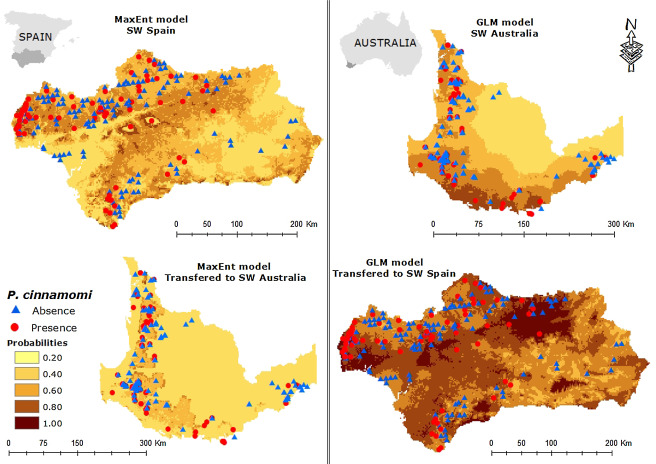 Duque-Lazo, J., van Gils, H., Groen, T. A., & Navarro-Cerrillo, R. M. (2016). Transferability of species distribution models: The case of Phytophthora cinnamomi in Southwest Spain and Southwest Australia. Ecological Modelling, 320, 62-70.
Duque-Lazo, J., van Gils, H., Groen, T. A., & Navarro-Cerrillo, R. M. (2016). Transferability of species distribution models: The case of Phytophthora cinnamomi in Southwest Spain and Southwest Australia. Ecological Modelling, 320, 62-70.
DOI: 10.1016/j.ecolmodel.2015.09.019
Species distributions may be assessed through interpolation for contiguous/adjacent areas without species occurrence, extrapolation for a geographic range wider than the calibration area of the model, or transferring a model calibrated in one region or time period to a disjunctive region or to a different period. Transferability of SDMs can be helpful in assessing the impacts of climate change on biodiversity, but transferability performance of SDMs between two disjunctive areas is poorly understood. This paper seeks to determine if models that are locally highly accurate are also better when transferred to a disjunctive area, identify which SDM algorithm(s) achieve the best transferability accuracy, and if model transferability accuracies depend on the number of variables included in the analysis. Using presence data for a species found across the world, models were constructed separately for two different regions (Spain and Australia). Models trained and calibrated in Spain were transferred to Australia and vice-versa. The transferability accuracy was calculated as an accuracy index in which the accuracy of the model when transferred was divided by the accuracy of the model within its training region. Models trained in Spain resulted in higher AUC values than those trained within Australia. GAM and GLM models were best transferred across the continents, though MaxEnt was the most stable model when transferred. Models transferred to Spain were more accurate than those transferred to Australia. This difference in transferability between models trained in different regions may be due to differences in value ranges in environmental variables. To reduce this uncertainty it is recommended that both the similarity in the mean value of variables and the range of the variables values be standardized across regions. While models developed in Spain showed high predictive performance within the training area, this performance did not translate to high transferability; indicating that high predictive performance does not guarantee high transferability. GLMs performed well within both the training region and the disjointed region transferring in both directions, while MaxEnt performed well in both training regions, but only transferred well in one direction. The ability to apply models outside of the training extent may allow us to understand more about how climate change will influence biodiversity and species distributions in the future, but we must address the uncertainties presented by predicting on environments that contain vastly different distributions of environmental conditions when compared to the training region as this can influence the predictive performance of the model.
